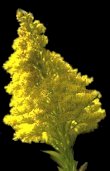|
**disclaimer: If any of the images belong to you and if you want credit or want them removed please email me**
MEANINGS & LEGENDS OF FLOWERS (G)

 Garlic
Garlic
Allium sativum
Family: Amaryllidaceae
Garlic belongs to the same family as onions, leeks and shallots. It originated in Siberia, then spread to the Mediterranean. It was present in the diets of early Romans, Greeks, and Egyptians. Chinese scholars wrote praises of garlic in 3000 B.C. and it is mentioned in the earliest Sanskrit writings. The sacrificial lambs of China were seasoned with garlic to make them more acceptable to the gods.
It was worshipped by ancient Egyptians as a god, and its name was invoked at oath takings. They believed that eating garlic conferred strength. Garlic is burned on Fridays in Egypt to ward off evil. The Egyptians could purchase a male slave for fifteen pounds of garlic. The Greek Historian, Herodotus, tells us that the workers constructing the Great Pyramid at Giza lived mainly on garlic and onions. It is said that pyramid builders went on strike when deprived of their ration of garlic.
The Israelites, wandering in the Sinai desert with nothing but manna to keep them from starvation, complained bitterly at the absence of garlic in their diets. The early Sumerian diet also included garlic and it is also mentioned in the Shih Ching ~The Book of Songs,~ a collection of traditional ballads, written by Confucius.
In the eighth century, B.C., garlic was found growing in the gardens of the King of Babylon. The Vikings and Phoenicians packed it into sea chests for long voyages, and in Boccaccio's Decameron a love stricken man sent garlic to a lady in order to win her love. Crusaders, returning to Europe from battle, are are said to have brought garlic along with them. Marco Polo mentioned the many uses of garlic in records of his journeys.
Ulysses ate garlic to protect himself from Circe's magic.
Jupiter revealed to Numa Pompilius that a sacrifice consisting of a head of garlic, human hair and a fish's life would avert lightning.
Romans believed that garlic increased stamina whereas in ancient Greece and Turkey it was believed to avert vampires. In Balkan countries, garlic rubbed on doorknobs and window frames was believed to discourage vampires. Jockeys rub the horse's bit with garlic or tie a clove of garlic to the bridle and feel sure no other horse can then pass them in a race. Bull fighters wear a clove of garlic, around their necks to protect themselves from the horns of the bull.
Garlic has occult properties and garlic cloves are worn for protection. It acts as a charm against the evil eye. Kept by the bed it guarded against vampires and aided in dreaming. It is considered a sign of great good fortune to dream of garlic but not to dream of giving it away, which is symbolic of giving away one's good luck. Wreaths of garlic hung outside the door are said to ward off witches and in new boats and houses it acts as a charm against envy. A clove of garlic suspended around the neck protects the wearer in his travels.
Christians believed that garlic sprang up wherever the devil's right foot stepped when he left the Garden of Eden.
In France garlic is roasted on Midsummer Eve for protection. In the Far East it is believed to have the power to bring back lost souls being heavily used in religious ceremonies. It is also seen to be an effective aphrodisiac.
~Vinegar of the four thieves'~ was the name given to a drink made from garlic taken in the 17th century by thieves and plague victims to prevent infection. In World War 1 French Army cleaned their wounds with it. It is used for strength, healing, exorcism and repels withches.
An ancient Indian proverb says: ~Garlic is as good as ten mothers. ~ A 17th century writer wrote, ~Our doctor is a clove of garlic.~
It was believed that garlic grew as the moon waned. Garlic has many medicinal uses. As a glue, enables holes to be drilled in glass. Sprinkle cloves over stored fruit to delay rotting. Hens lay more eggs when garlic is mixed with their food.
It was so popular in Europe that banquet guests were required to compose verses saluting it. Missionaries introduced garlic to California. Today California supplies 90 % of garlic grown in the United States of America. Garlic contains the amino acid, allicin which scientists say has antibiotic and bactericidal effects. Garlic was recommended for every ailment from the common cold to unrequited love. It was laid on a baby's navel or applied to the soles of a patient's feet because the volatile oils in garlic were readily absorbed.

 Gerbera Daisy
Gerbera Daisy
Gerbera jamesonii
Family: Asteraceae
Common Names: ~African Daisy~ ~Transvaal Daisy~ ~Barberton Daisy ~
The gerbera daisy, known as the ~Transvaal Daisy,~ originated in South Africa. Named after German naturalist Traugott Gerber, a German botanist and naturalist, who traveled extensively in Russia. The Gerbera one of the world's top ten most popular flowers.
Flower developers have created miniature gerberas, called ~Germini~ hybrids. Germini were bred to have strong necks that help flowers stay erect. These gerbera daisy heads are only two inches across, but their colors are as vibrant as the larger daisies. It is associated with star sign Leo. Flowers have a vase-life of 7 - 12 days.

 Gladioli
Gladioli
Gladiolus grandiflorus
Family: Iridaceae
Common Names: ~Corn Lilies~ ~Glads~ ~Sword Lilies~
A member of the Iris family, it originated in Africa. Gladiolus species were recognized over 2,000 years ago growing in the fields of Asia Minor and were called ~corn lilies.~ They began being used as cut flowers in North America in the early 1800s. Today, there are at least 180 known species. It's name was derived from the Latin word ~gladius,~ meaning the ~little sword.~ It is considered to be the flower of the Gladiators, called ~sword lily,~ because of the shape of the leaves.
Mashed gladiolus roots were used in medicine for drawing out splinters and thorns. Dried gladiolus seed pods were ground to powder and swallowed with goat's milk, as a remedy for colic. However, modern medicine has proven these gladiolus remedies to be untrue.
The engineer who built the bridge over the Zambesi river at Victoria Falls, Sir F. Fox, developed miniature hybrids from the gladiolus primulinus, and sent them to Kew Gardens, known as the ~Maid in the Mist.~
Gladiolus grew abundantly and wild in the Holy Land and the waste lands along the Mediterranean coast of Africa. They were thought to be the ~lilies of the field~ that Jesus referred to in the Sermon on the Mount.
Flower of August, Gladioli have a vase life of 10 - 14 days.
~Flower of the Gladiators~ (Roman)
In the language of flowers it signifies ~Strength of Character~

 Guaria Morada
Guaria Morada
cattleya skinneri
Family: Orchideaceae
Common Names: ~Flor de San Sebastian~
Guaria Morada, a beautiful purple orchid, was established as the National flower of Costa Rica in 1939, under the presidency of León Cortés. It is found at the Rincón de la Vieja Volcano.
It was named in honor of William Cattley, English horticulturist during the nineteenth century.
Cattleya skinneri is one of the top ten orchids and is known as ~Flor de San Sebastian~ throughout Central America. It is nearly extinct in Costa Rica but due to its popularity it is common in collections.

 Godetia
Godetia
Clarkia Amoena
Family: Onagraceae
~Satin Flower~ ~Silk Flower~ ~Farewell-to-Spring ~
Named for the explorer Captain William Clark of the famous Lewis and Clark expedition, the clarkias are found on dry open slopes in the forests of the Northwest, from California north to British Columbia.

 Goldenrod
Goldenrod
Solidago virgaurea
Family: Asteraceae ~Compositae~
Common Names: ~Solidago~ ~Virgaureae herba~ ~European Goldenrod~ ~Missouri Goldenrod~ ~Sweet Goldenrod~ ~Wound Weed~ ~Woundwort~ ~Blue Mountain Tea~ ~Sweet-scented Goldenrod~ ~Anise-scented Goldenrod~ ~True Goldenrod~
Goldenrod belongs to the Sunflower Family. It is native to Europe. There are about 125 species of goldenrod around the world; around 90 are found in North America. Goldenrod gets its name from the two Latin words ~solidus~ and ~agere~ which means ~make strong~ or ~make healthy.~
The Chippewa Indians called it ~gizisomukiki,~ meaning ~sun medicine.~ The plant has been used medicinally, for a number of ailments. Californians used the Solidago californica to treat sores and cuts, calling the plant ~oreja de liebre~ which means ~jack rabbit's ear~ supposedly the shape of the leaf.
The Great Saladin ~1137-93~ the poor boy who rose to be caliph of Egypt and fought King Richard in the Third Crusade, greatly treasured goldenrod as a medicine and introduced its cultivation into the Middle East where it long remained an important crop.
When Mediterranean-grown S. virgaurea was first introduced into Elizabethan England as a medicinal herb, it commanded high prices, as much as a half-crown an ounce. However, when the very same species was found growing wild, its monetary value plummeted and so did its popularity.
Goldenrod has often been blamed as a chief cause of hayfever. Brews of goldenrod were popular and witches were said to have used goldenrod in potions. In Europe, the leaves were sometimes concocted into what was called Blue Mountain wine. Teas were brewed in both Europe and in North America, particularly by the Indians. Medicinal extracts and tea leaves made from the aromatic American species as fragrant goldenrod S. odora were exported in the 19th Century to China, where they commanded high prices.
The flowers of various species of goldenrods have been used to make yellow dyes for cloth. Nowadays, it is used as beautiful cutflower. Goldenrod is depicted on the state flag of Kentucky. It is the state flower of Kentucky and Nebraska, USA.

 Geranium
Geranium
Geranium spp.
Family: Geraniaceae
Common Names: ~Cranesbill~
The name ~Geranium~ means ~Crane Flower~ refering to the shape of the seed, which resembles a crane's bill.
The Geraniaceae Family includes the genus Pelargonium and the genus Geranium. The geranium flowers are symmetrical while the pelargonium flowers are not. The pelargonium flowers have a nectary tube behind the petals, the geranium does not.
The geranium (cranesbill) is herbaceous, grown in flowerbeds in gardens and dying down in winter.
The pelargonium (storksbill) is mistakenly called Geranium and comprises of nearly 250 species.
Geranium is known to the Japanese as a ~sociable plant.~ Legend says that it was a weed. One day the prophet Mohammed came down from the mountain, and hung his sweaty shirt on the geranium. The geranium held the shirt up to the sun until it was completely dry. Mohammed was very pleased to the point that he covered the plant with velvety red blossoms that filled the air with a fragrance.
It is said that snakes will not go near places where white geraniums grow, and that if it is kept near the window, flies will not come in. American Indians believed that the root of the geranium could cure sore throats and stop internal bleeding.
|


Copyright © Pinkie D'Cruz 1998
Friday, January 16, 1998


|